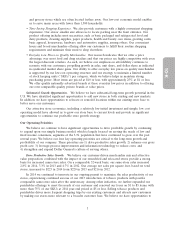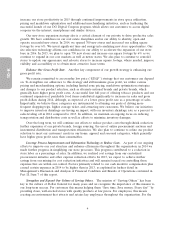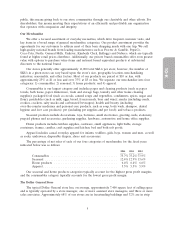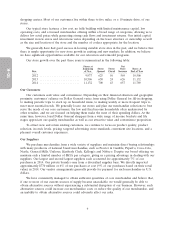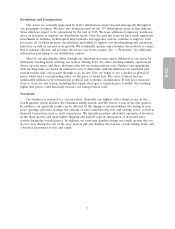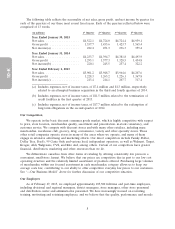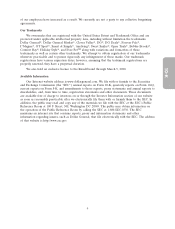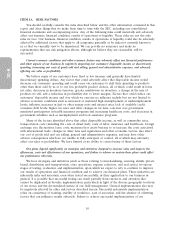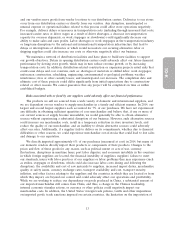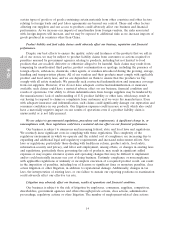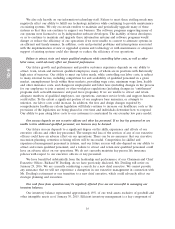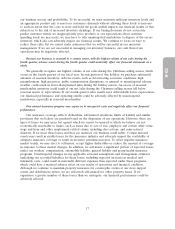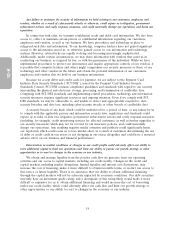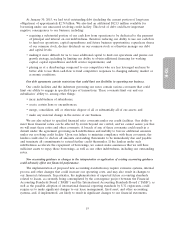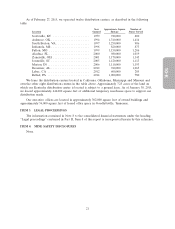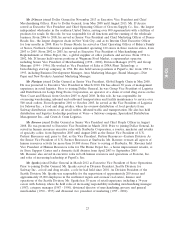Dollar General 2014 Annual Report Download - page 87
Download and view the complete annual report
Please find page 87 of the 2014 Dollar General annual report below. You can navigate through the pages in the report by either clicking on the pages listed below, or by using the keyword search tool below to find specific information within the annual report.
10-K
and our vendors move goods from vendor locations to our distribution centers. Deliveries to our stores
occur from our distribution centers or directly from our vendors. Any disruption, unanticipated or
unusual expense or operational failure related to this process could affect store operations negatively.
For example, delivery delays or increases in transportation costs (including through increased fuel costs,
increased carrier rates or driver wages as a result of driver shortages, a decrease in transportation
capacity for overseas shipments, or work stoppages or slowdowns) could significantly decrease our
ability to make sales and earn profits. Labor shortages or work stoppages in the transportation industry
or long-term disruptions to the national and international transportation infrastructure that lead to
delays or interruptions of deliveries or which would necessitate our securing alternative labor or
shipping suppliers could also increase our costs or otherwise negatively affect our business.
We maintain a network of distribution facilities and have plans to build new facilities to support
our growth objectives. Delays in opening distribution centers could adversely affect our future financial
performance by slowing store growth, which may in turn reduce revenue growth, or by increasing
transportation costs. In addition, distribution-related construction or expansion projects entail risks that
could cause delays and cost overruns, such as: shortages of materials or skilled labor; work stoppages;
unforeseen construction, scheduling, engineering, environmental or geological problems; weather
interference; fires or other casualty losses; and unanticipated cost increases. The completion date and
ultimate cost of these projects could differ significantly from initial expectations due to construction-
related or other reasons. We cannot guarantee that any project will be completed on time or within
established budgets.
Risks associated with or faced by our suppliers could adversely affect our financial performance.
The products we sell are sourced from a wide variety of domestic and international suppliers, and
we are dependent on our vendors to supply merchandise in a timely and efficient manner. In 2014, our
largest and second largest suppliers each accounted for 7% of our purchases. We have not experienced
any difficulty in obtaining sufficient quantities of core merchandise and believe that, if one or more of
our current sources of supply became unavailable, we would generally be able to obtain alternative
sources without experiencing a substantial disruption of our business. However, such alternative sources
could increase our merchandise costs, result in a temporary reduction in store inventory levels, and
reduce the quality of our merchandise, and an inability to obtain alternative sources could adversely
affect our sales. Additionally, if a supplier fails to deliver on its commitments, whether due to financial
difficulties or other reasons, we could experience merchandise out-of-stocks that could lead to lost sales
and damage to our reputation.
We directly imported approximately 6% of our purchases (measured at cost) in 2014, but many of
our domestic vendors directly import their products or components of their products. Changes to the
prices and flow of these goods for any reason, such as political unrest or acts of war, currency
fluctuations, disruptions in maritime lanes, port labor disputes, and economic instability in the countries
in which foreign suppliers are located, the financial instability of suppliers, suppliers’ failure to meet
our standards, issues with labor practices of our suppliers or labor problems they may experience (such
as strikes, stoppages or slowdowns, which could also increase labor costs during and following the
disruption), the availability and cost of raw materials to suppliers, increased import duties, merchandise
quality or safety issues, currency exchange rates, transport availability and cost, transport security,
inflation, and other factors relating to the suppliers and the countries in which they are located or from
which they import, are beyond our control and could adversely affect our operations and profitability.
While we are working to reduce our dependency on goods produced in China, a substantial amount of
our imported merchandise still comes from China, and thus, a change in the Chinese leadership,
internal economic stimulus actions, or currency or other policies could negatively impact our
merchandise costs. In addition, the United States’ foreign trade policies, tariffs and other impositions
on imported goods, trade sanctions imposed on certain countries, the limitation on the importation of
13


